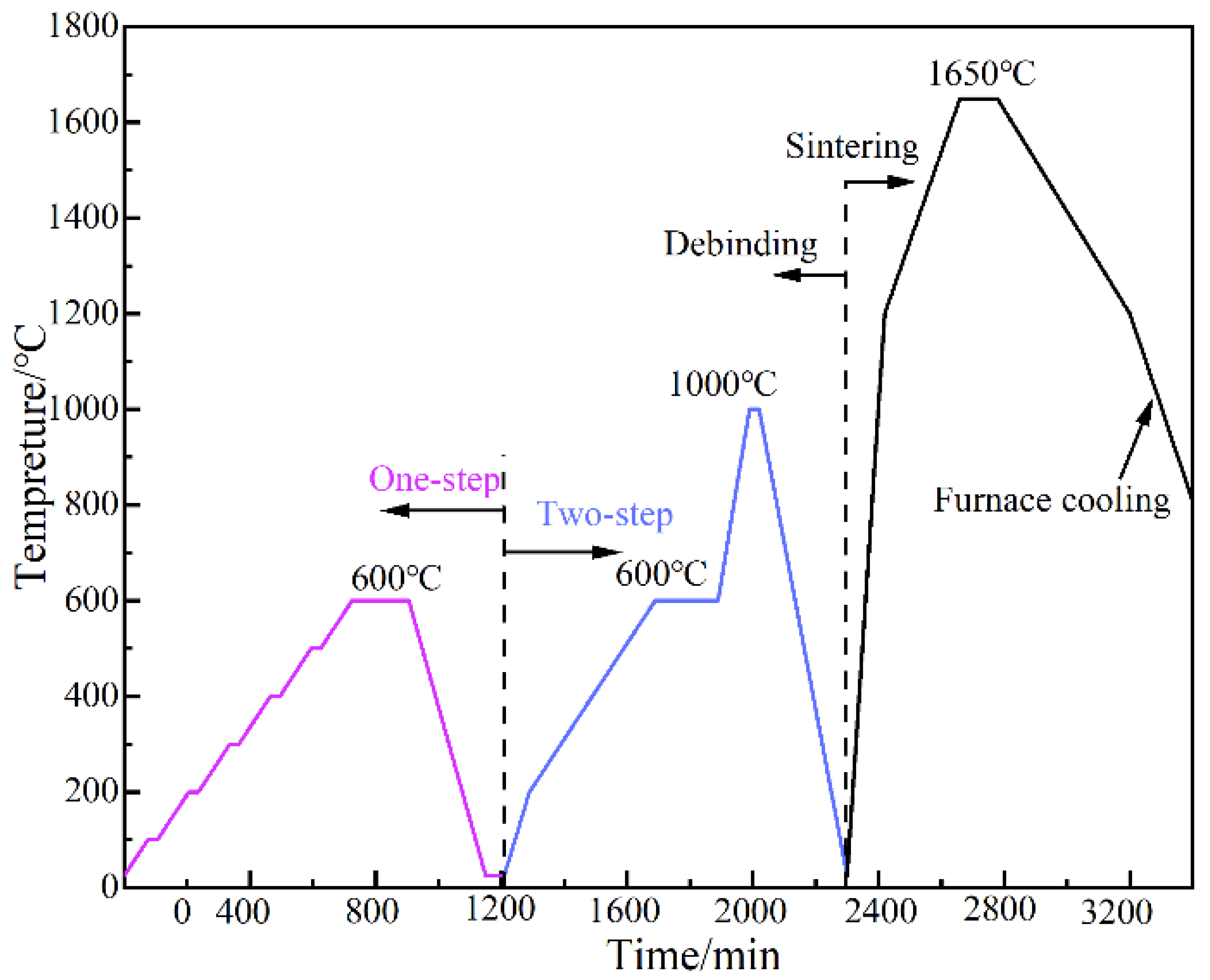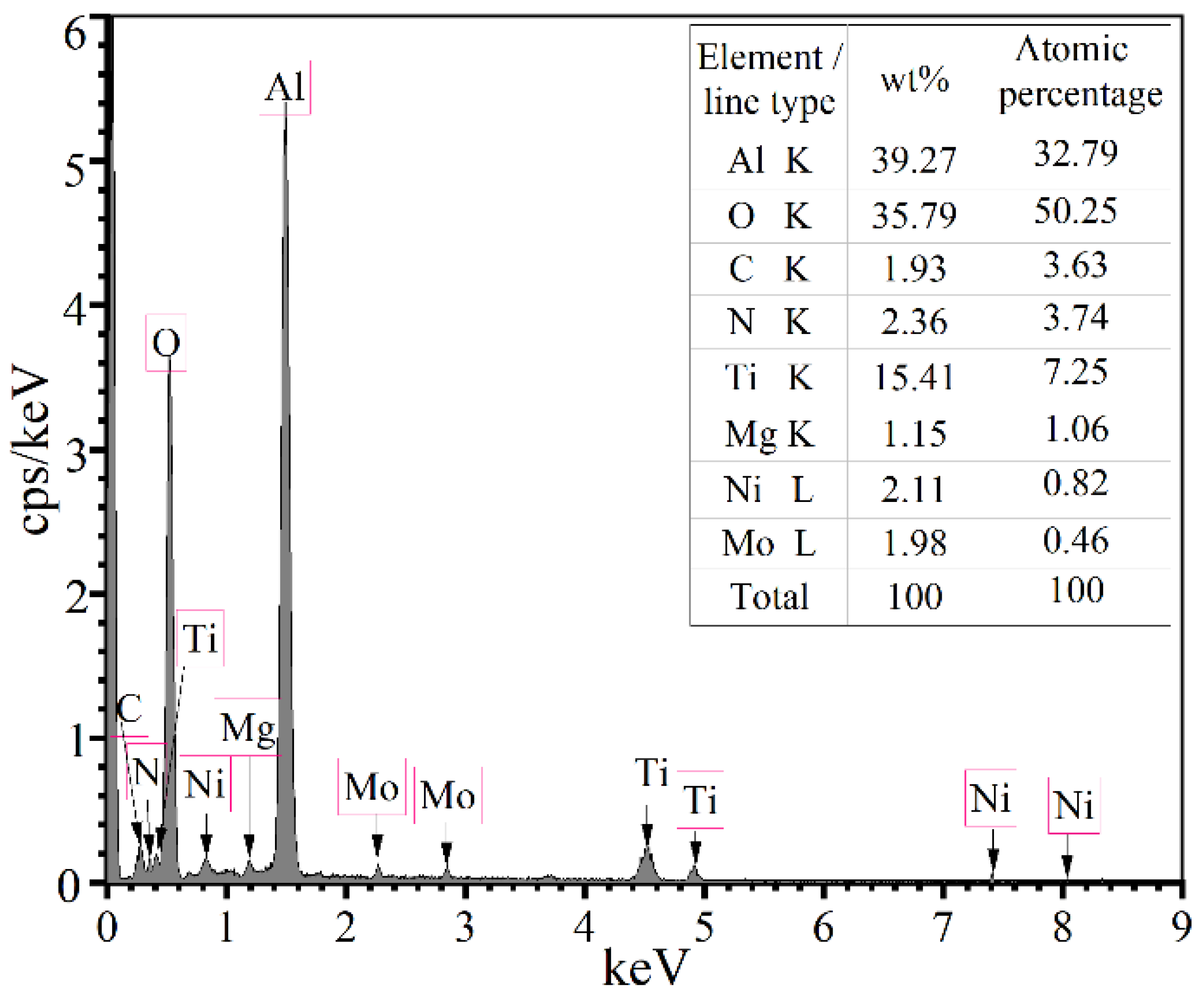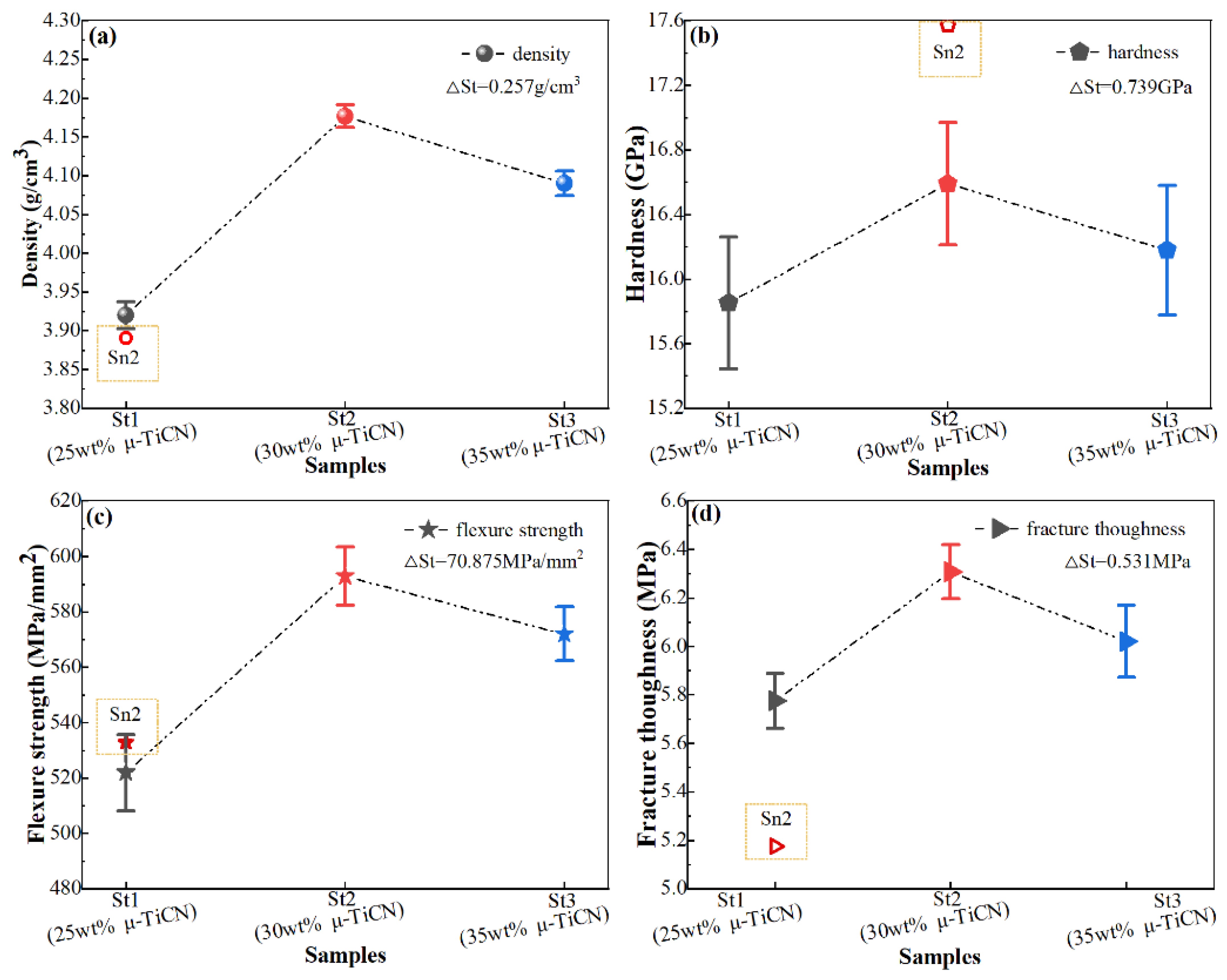Effects of n-Al2O3 and μ-TiCN on Microstructure and Mechanical Properties of Al2O3 Composite Ceramics Manufactured by Material Extrusion and Photo-Polymerization Combined Process
Abstract
:1. Introduction
2. Materials and Methods
3. Results and Discussion
3.1. Effects of n-Al2O3 on the Microstructure and Mechanical Properties
3.2. Effects of μ-TiCN on the Microstructure and Mechanical Properties
4. Conclusions
- (1)
- n-Al2O3 has a significant effect on the hardness of Al2O3 composite ceramics. The change in hardness of Sn-x type ceramics effected with n-Al2O3 was 1.118 GPa, which was higher than the change in St-x type ceramics effected with μ-TiCN (0.739 GPa). The volume density and porosity of 10 wt % n-Al2O3 ceramics are improved, which is better than that of the other Sn-x ceramics.
- (2)
- The volume density, flexural strength and fracture toughness of Al2O3 composite ceramics affected by μ-TiCN change significantly. The changes of volume density, flexural strength and fracture toughness of St-x type ceramics affected by optimum ratio 30 wt % μ-TiCN were at 0.257 g/cm3, 70.875 MP and 0.531 MPa/mm2, respectively, which were higher than the changes in Sn-x type ceramics effected with 10 wt % n-Al2O3 (0.091 g/cm3, 24 MPa and 0.205 MPa/mm2).
- (3)
- The best ratio of 10 wt % n-Al2O3 and 30 wt % μ-TiCN optimized the microstructure and mechanical properties of Al2O3 composite ceramics. The porosity and volume density were at 4.073% and 4.177 g/cm3, and the hardness, flexural strength and fracture toughness were 16.592 GPa, 592.875 MPa and 6.308 MPa/mm2. The flexural strength of composite ceramics fabricated is higher than that of Al2O3 ceramics prepared by SLA in reference [27] (178.84 ± 17.66 MPa), which has the potential of high-pressure resistant structural materials.
Author Contributions
Funding
Institutional Review Board Statement
Informed Consent Statement
Data Availability Statement
Conflicts of Interest
References
- Jianxin, D.; Zhenxing, D.; Dongling, Y.; Hui, Z.; Xing, A.; Jun, Z. Fabrication and performance of Al2O3/(W,Ti)C+ Al2O3/TiC multilayered ceramic cutting tools. Mater. Sci. Eng. A-Struct. 2010, 527, 1039–1047. [Google Scholar] [CrossRef]
- Norfauzi, T.; Hadzley, A.B.; Azlan, U.A.A.; Afuza, A.A.; Faiz, M.M.; Naim, M.F. Fabrication and machining performance of ceramic cutting tool based on the Al2O3-ZrO2-Cr2O3 compositions. Mater. Res. Technol. 2019, 8, 5114–5123. [Google Scholar] [CrossRef]
- Qu, X.; Wang, F.; Shi, C.; Zhao, N.; Liu, E.; He, C.; He, F. In situ synthesis of a gamma-Al2O3 whisker reinforced aluminium matrix composite by cold pressing and sintering. Mater. Sci. Eng. A-Struct. 2018, 709, 223–231. [Google Scholar] [CrossRef]
- Du, J.; Tang, B.; Liu, W.; Zhang, T.; Peng, J.; Chen, H.; Lei, Y. Effects of annealing and firing in wet hydrogen on the dielectric breakdown strengths of alumina ceramics. J. Adv. Ceram. 2020, 9, 173–182. [Google Scholar] [CrossRef] [Green Version]
- Ponder, R.I.; Safaei, M.; Anton, S.R. Fabrication and selection of surrogate knee implant bearings for experimental evaluation of embedded in-vivo sensors. J. Mech. Behav. Biomed. Mater. 2019, 91, 237–246. [Google Scholar] [CrossRef]
- Ivanov, K.V.; Fortuna, S.V.; Kalashnikova, T.A.; Glazkova, E.A. Effect of Alumina Nanoparticles on the Microstructure, Texture, and Mechanical Properties of Ultrafine-Grained Aluminum Processed by Accumulative Roll Bonding. Adv. Eng. Mater. 2019, 21, 1701135. [Google Scholar] [CrossRef] [Green Version]
- Han, D.; Yang, C.; Fang, N.X.; Lee, H. Rapid multi-material 3D printing with projection micro-stereolithography using dynamic fluidic control. Addit. Manuf. 2019, 27, 606–615. [Google Scholar] [CrossRef]
- Zocca, A.; Colombo, P.; Gomes, C.M.; Günster, J.; Green, D.J. Additive Manufacturing of Ceramics: Issues, Potentialities, and Opportunities. J. Am. Ceram. Soc. 2015, 98, 1983–2001. [Google Scholar] [CrossRef]
- Lakhdar, Y.; Tuck, C.; Binner, J.; Terry, A.; Goodridge, R. Additive manufacturing of advanced ceramic materials. Prog. Mater. Sci. 2021, 116, 100736. [Google Scholar] [CrossRef]
- Chen, Z.; Li, Z.; Li, J.; Liu, C.; Lao, C.; Fu, Y.; Liu, C.; Li, Y.; Wang, P.; He, Y. 3D printing of ceramics: A review. J. Eur. Ceram. Soc. 2019, 39, 661–687. [Google Scholar] [CrossRef]
- Hwa, L.C.; Rajoo, S.; Noor, A.M.; Ahmad, N.; Uday, M.B. Recent advances in 3D printing of porous ceramics: A review. Curr. Opin. Solid State Mater. Sci. 2017, 21, 323–347. [Google Scholar] [CrossRef]
- Mao, M.; He, J.; Li, X.; Zhang, B.; Lei, Q.; Liu, Y.; Li, D. The Emerging Frontiers and Applications of High-Resolution 3D Printing. Micromachines 2017, 8, 113. [Google Scholar] [CrossRef]
- Xing, H.Y.; Zou, B.; Lai, Q.G.; Huang, C.Z.; Chen, Q.H.; Fu, X.S.; Shi, Z.Y. Preparation and characterization of UV curable Al2O3 suspensions applying for stereolithography 3D printing ceramic microcomponent. Powder Technol. 2018, 338, 153–161. [Google Scholar] [CrossRef]
- He, R.; Liu, W.; Wu, Z.; An, D.; Huang, M.; Wu, H.; Jiang, Q.; Ji, X.; Wu, S.; Xie, Z. Fabrication of complex-shaped zirconia ceramic parts via a DLP-stereolithography-based 3D printing method. Ceram. Int. 2018, 44, 3412–3416. [Google Scholar] [CrossRef]
- Ghazanfari, A.; Li, W.; Leu, M.C.; Hilmas, G.E. A novel freeform extrusion fabrication process for producing solid ceramic components with uniform layered radiation drying. Addit. Manuf. 2017, 15, 102–112. [Google Scholar] [CrossRef] [Green Version]
- Zhou, M.P.; Liu, W.; Wu, H.D.; Song, X.; Chen, Y.; Cheng, L.X.; He, F.P.; Chen, S.X.; Wu, S.H. Preparation of a defect-free alumina cutting tool via additive manufacturing based on stereolithography—Optimization of the drying and debinding processes. Ceram. Int. 2016, 42, 11598–11602. [Google Scholar] [CrossRef]
- Schmidt, J.; Altun, A.A.; Schwentenwein, M.; Colombo, P. Complex mullite structures fabricated via digital light processing of a preceramic polysiloxane with active alumina fillers. J. Eur. Ceram. Soc. 2019, 39, 1336–1343. [Google Scholar] [CrossRef]
- Chen, J.; Bao, E.; Huang, D.; Ding, Y.; Qiu, X. Extrusion Freeforming-Based 3D Printing of Ceramic Materials. Mater. Trans. 2020, 61, 2236–2240. [Google Scholar] [CrossRef]
- Ghazanfari, A.; Li, W.; Leu, M.; Watts, J.; Hilmas, G. Mechanical characterization of parts produced by ceramic on-demand extrusion process. Int. J. Appl. Ceram. Technol. 2017, 14, 486–494. [Google Scholar] [CrossRef] [Green Version]
- Pierin, G.; Grotta, C.; Colombo, P.; Mattevi, C. Direct Ink Writing of micrometric SiOC ceramic structures using a preceramic polymer. J. Eur. Ceram. Soc. 2016, 36, 1589–1594. [Google Scholar] [CrossRef]
- Liu, W.; Li, M.; Nie, J.; Wang, C.; Li, W.; Xing, Z. Synergy of solid loading and printability of ceramic paste for optimized properties of alumina via stereolithography-based 3D printing. Mater. Res. Technol. 2020, 9, 11476–11483. [Google Scholar] [CrossRef]
- Moghadasi, M.; Du, W.; Li, M.; Pei, Z.; Ma, C. Ceramic binder jetting additive manufacturing: Effects of particle size on feedstock powder and final part properties. Ceram. Int. 2020, 46, 16966–16972. [Google Scholar] [CrossRef]
- Li, X.; Liu, C.; Sun, B.; Liu, X.; Zuo, Z.; Shu, Y.; Zeng, X.; Yi, J.; Chen, H.; Liu, Y.; et al. Refined grain size of ITO ceramic targets prepared by pressure slip casting and two-step sintering. J. Eur. Ceram. Soc. 2021, 41, 3501–3511. [Google Scholar] [CrossRef]
- Liu, W.; Wu, H.; Zhou, M.; He, R.; Jiang, Q.; Wu, Z.; Cheng, Y.; Song, X.; Chen, Y.; Wu, S. Fabrication of fine-grained alumina ceramics by a novel process integrating stereolithography and liquid precursor infiltration processing. Ceram. Int. 2016, 42, 17736–17741. [Google Scholar] [CrossRef]
- Xu-Guo, H.; Zi-Shang, C.; Xiao-Ping, L.; Sheng, B. Effect of sintering additives size on the microstructure and wear properties of Al2O3 ceramics. Ferroelectrics 2017, 521, 101–107. [Google Scholar] [CrossRef]
- Wu, H.; Cheng, Y.; Liu, W.; He, R.; Zhou, M.; Wu, S.; Song, X.; Chen, Y. Effect of the particle size and the debinding process on the density of alumina ceramics fabricated by 3D printing based on stereolithography. Ceram. Int. 2016, 42, 17290–17294. [Google Scholar] [CrossRef]
- Zhang, K.; He, R.; Ding, G.; Bai, X.; Fang, D. Effects of fine grains and sintering additives on stereolithography additive manufactured Al2O3 ceramic. Ceram. Int. 2021, 47, 2303–2310. [Google Scholar] [CrossRef]
- Sun, C.; Tian, X.; Wang, L.; Liu, Y.; Wirth, C.M.; Günster, J.; Li, D.; Jin, Z. Effect of particle size gradation on the performance of glass-ceramic 3D printing process. Ceram. Int. 2017, 43, 578–584. [Google Scholar] [CrossRef]
- He, X.; Xu, J.; Ji, W. The effect of surfactants on the performances of ceramic slurry by material extrusion and photo-polymerization combined molding process. J. Ceram. Soc. Jpn. 2021, 129, 489–495. [Google Scholar] [CrossRef]
- Lóh, N.J.; Simão, L.; Jiusti, J.; Arcaro, S.; Raupp-Pereira, F.; De Noni, A.; Montedo, O.R.K. Densified alumina obtained by two-step sintering: Impact of the microstructure on mechanical properties. Ceram. Int. 2020, 46, 12740–12743. [Google Scholar] [CrossRef]







| Samples | μ-Al2O3 | n-Al2O3 | μ-TiCN | Ni | Mo | MgO |
|---|---|---|---|---|---|---|
| Sn1 | 69 | 5 | 20 | 2 | 2 | 2 |
| Sn2 | 64 | 10 | 20 | 2 | 2 | 2 |
| Sn3 | 59 | 15 | 20 | 2 | 2 | 2 |
| St1 | 59 | 10 | 25 | 2 | 2 | 2 |
| St2 | 54 | 10 | 30 | 2 | 2 | 2 |
| St3 | 49 | 10 | 35 | 2 | 2 | 2 |
Publisher’s Note: MDPI stays neutral with regard to jurisdictional claims in published maps and institutional affiliations. |
© 2022 by the authors. Licensee MDPI, Basel, Switzerland. This article is an open access article distributed under the terms and conditions of the Creative Commons Attribution (CC BY) license (https://creativecommons.org/licenses/by/4.0/).
Share and Cite
He, X.; Xu, J.; Ji, W. Effects of n-Al2O3 and μ-TiCN on Microstructure and Mechanical Properties of Al2O3 Composite Ceramics Manufactured by Material Extrusion and Photo-Polymerization Combined Process. Crystals 2022, 12, 745. https://doi.org/10.3390/cryst12050745
He X, Xu J, Ji W. Effects of n-Al2O3 and μ-TiCN on Microstructure and Mechanical Properties of Al2O3 Composite Ceramics Manufactured by Material Extrusion and Photo-Polymerization Combined Process. Crystals. 2022; 12(5):745. https://doi.org/10.3390/cryst12050745
Chicago/Turabian StyleHe, Xin, Jie Xu, and Weixi Ji. 2022. "Effects of n-Al2O3 and μ-TiCN on Microstructure and Mechanical Properties of Al2O3 Composite Ceramics Manufactured by Material Extrusion and Photo-Polymerization Combined Process" Crystals 12, no. 5: 745. https://doi.org/10.3390/cryst12050745
APA StyleHe, X., Xu, J., & Ji, W. (2022). Effects of n-Al2O3 and μ-TiCN on Microstructure and Mechanical Properties of Al2O3 Composite Ceramics Manufactured by Material Extrusion and Photo-Polymerization Combined Process. Crystals, 12(5), 745. https://doi.org/10.3390/cryst12050745





